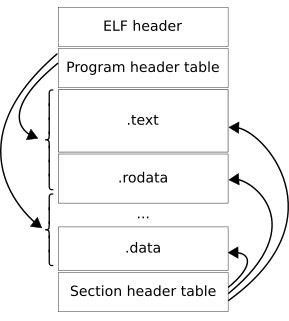See also
| This disambiguation page lists articles associated with the title Fat object. If an internal link led you here, you may wish to change the link to point directly to the intended article. |
Fat object may refer to:
| This disambiguation page lists articles associated with the title Fat object. If an internal link led you here, you may wish to change the link to point directly to the intended article. |

In computing, the Executable and Linkable Format, is a common standard file format for executable files, object code, shared libraries, and core dumps. First published in the specification for the application binary interface (ABI) of the Unix operating system version named System V Release 4 (SVR4), and later in the Tool Interface Standard, it was quickly accepted among different vendors of Unix systems. In 1999, it was chosen as the standard binary file format for Unix and Unix-like systems on x86 processors by the 86open project.

A binary star is a star system consisting of two stars orbiting around their common barycenter. Systems of two or more stars are called multiple star systems. These systems, especially when more distant, often appear to the unaided eye as a single point of light, and are then revealed as multiple by other means.
The Portable Executable (PE) format is a file format for executables, object code, DLLs and others used in 32-bit and 64-bit versions of Windows operating systems. The PE format is a data structure that encapsulates the information necessary for the Windows OS loader to manage the wrapped executable code. This includes dynamic library references for linking, API export and import tables, resource management data and thread-local storage (TLS) data. On NT operating systems, the PE format is used for EXE, DLL, SYS, and other file types. The Extensible Firmware Interface (EFI) specification states that PE is the standard executable format in EFI environments.

X-ray binaries are a class of binary stars that are luminous in X-rays. The X-rays are produced by matter falling from one component, called the donor, to the other component, called the accretor, which is very compact: a neutron star or black hole. The infalling matter releases gravitational potential energy, up to several tenths of its rest mass, as X-rays. The lifetime and the mass-transfer rate in an X-ray binary depends on the evolutionary status of the donor star, the mass ratio between the stellar components, and their orbital separation.

A minor-planet moon is an astronomical object that orbits a minor planet as its natural satellite. As of October 2020, there are 416 minor planets known or suspected to have moons. Discoveries of minor-planet moons are important because the determination of their orbits provides estimates on the mass and density of the primary, allowing insights of their physical properties that is generally not otherwise possible.
A Binary Large OBject (BLOB) is a collection of binary data stored as a single entity in a database management system. Blobs are typically images, audio or other multimedia objects, though sometimes binary executable code is stored as a blob. Database support for blobs is not universal.
An object file is a computer file containing object code, that is, machine code output of an assembler or compiler. The object code is usually relocatable, and not usually directly executable. There are various formats for object files, and the same machine code can be packaged in different object file formats. An object file may also work like a shared library.
A binary system is a system of two astronomical bodies which are close enough that their gravitational attraction causes them to orbit each other around a barycenter (also see animated examples). More restrictive definitions require that this common center of mass is not located within the interior of either object, in order to exclude the typical planet–satellite systems and planetary systems.
A fat binary is a computer executable program or library which has been expanded with code native to multiple instruction sets which can consequently be run on multiple processor types. This results in a file larger than a normal one-architecture binary file, thus the name.
Mach-O, short for Mach object file format, is a file format for executables, object code, shared libraries, dynamically-loaded code, and core dumps. A replacement for the a.out format, Mach-O offers more extensibility and faster access to information in the symbol table.

Rosetta is a dynamic binary translator developed by Apple Inc. for macOS, an application compatibility layer between different CPU architectures. It gives developers and consumers a transition period in which to update their application software to run on newer hardware.

The universal binary format is, in Apple parlance, a format for executable files that run natively on either PowerPC or Intel-manufactured IA-32 or Intel 64-based Macintosh computers. The format originated on NeXTStep as "Multi-Architecture Binaries", and the concept is more generally known as a fat binary, as seen on Power Macintosh.
MPEG-4 Part 11Scene description and application engine was published as ISO/IEC 14496-11 in 2005. MPEG-4 Part 11 is also known as BIFS, XMT, MPEG-J. It defines:
In the macOS, iOS, NeXTSTEP, and GNUstep programming frameworks, property list files are files that store serialized objects. Property list files use the filename extension .plist, and thus are often referred to as p-list files.
File size is a measure of how much data a computer file contains or, alternately, how much storage it consumes. Typically, file size is expressed in units of measurement based on the byte. By convention, file size units use either a metric prefix or a binary prefix.
COM Structured Storage is a technology developed by Microsoft as part of its Windows operating system for storing hierarchical data within a single file. Strictly speaking, the term structured storage refers to a set of COM interfaces that a conforming implementation must provide, and not to a specific implementation, nor to a specific file format. In addition to providing a hierarchical structure for data, structured storage may also provide a limited form of transactional support for data access. Microsoft provides an implementation that supports transactions, as well as one that does not.
Fat is an oily or greasy organic substance.

A contact binary is a small Solar System body such as a minor planet or a comet that is composed of two bodies that have gravitated toward each other until they touch, resulting in a bilobated, peanut-like overall shape. Contact binaries are often rubble piles but distinct from real binary systems such as binary asteroids. The term is also used for stellar contact binaries.

Vala is an object-oriented programming language with a self-hosting compiler that generates C code and uses the GObject system.

In astronomy, a common envelope (CE) is gas that contains a binary star system. The gas does not rotate at the same rate as the embedded binary system. A system with such a configuration is said to be in a common envelope phase or undergoing common envelope evolution.